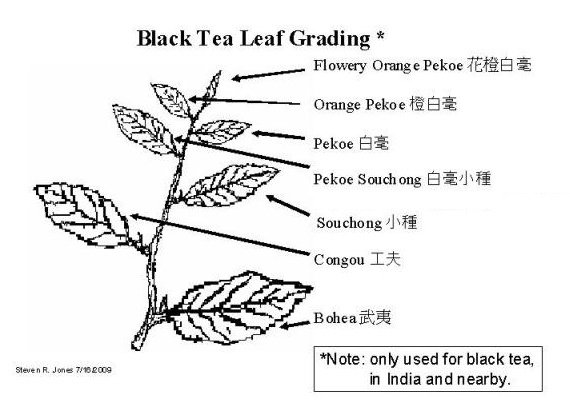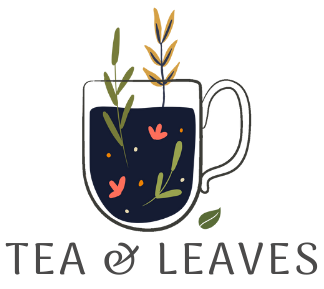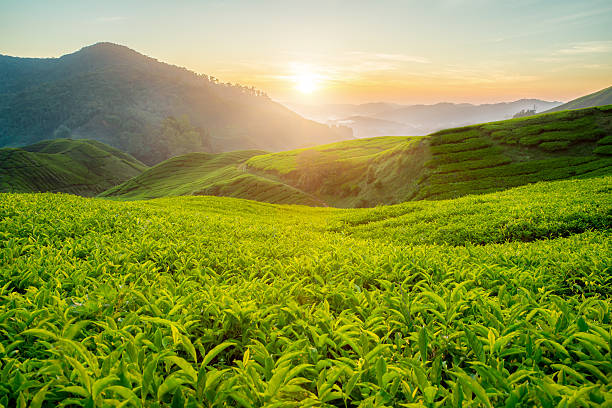All true tea is made from the leaves of a tea plant. There are two main tea plants from which tea is produced: Camellia Sinensis Sinensis native to China and Camillia Sinensis Assamica native to India. Over hundreds of years of cultivation more than 100 sub varieties of tea plant have been created. Each type has it’s own unique characteristics which are important for producing certain types of tea. For example, there are tea plants which produce large buds covered in tiny silvery hair that are used for making the finest white tea.
However, all types of tea can be made from one tea plant. It is the processing of the leaves which determines what kind of tea will be produced.
Black tea
Often taken with milk, it is the most common type of tea in Britain (for example English Breakfast Tea). The process for producing black tea comprises of five stages:
- Withering – in this stage tea leaves loose about two thirds of their moisture and become more pliable.
- Rolling – a special rolling machine presses and twists the leaves, breaking the cells inside and releasing natural juices.
- Oxidising – the natural juices react with the oxygen and turn the leaves black.
- Drying – to finish the oxidation and dry the leaves, they are placed in large hot air dryers.
- Sorting – the leaves are sorted according to their size.
Leaf grades used in black tea
Dust and Fannings – Used for cheaper teabags.
CTC – Cut Tear Curl = Large leaves and tips are cut into small pieces and then curled into little balls. They produce strong and rich infusions.
BOP – Broken Orange Pekoe = A broken large leaf.
OP – Orange Pekoe = Large leaf.
FOP – Flowery Orange Pekoe = End bud and large leaf.
GFOP – Golden Flowery Orange Pekoe = A golden bud and large leaf.
TGFOP – Tippy Golden Flowery Orange Pekoe = A large proportion of golden buds with large leaves.
FTGFOP – Fine Tippy Golden Flowery Orange Pekoe = A very high quality tea with a large proportion of golden tips.
SFTGFOP – Super Fine Tippy Golden Flowery Orange Pekoe = This is the absolute top quality tea, containing the highest amount of golden tips.
In general the higher proportion of golden tips, the lighter the tea infusion will be.

Green Tea
This is probably the most popular type of tea in the world, as it is so widely appreciated throughout Eastern Asia. Recently, many in the West have begun to enjoy it too, and it is often heralded for its excellent health properties. Known as un-oxidised tea, green tea is fired or steamed soon after picking to de-enzyme the leaves, which stops the oxidation process and prevents extra caffeine from being developed. It is then shaped, often giving it a distinctive appearance, before finally being dried.
White Tea
The most delicate of all teas, as well as being the lowest in caffeine and the highest in antioxidants. Made only from the buds and the top few leaves of the plant, it is also the least involved process, the leaves being dried very soon after they are picked. The name comes from the tiny silver-white hairs that cover the young buds of the tea plant.
Oolong Tea
Often mis-classified as either green or black tea, while the truth lies somewhere in between. Known as semi-oxidised tea, it is a distinct class in its own right and comes in green or darker varieties, depending on how much it has been oxidised (usually between 10-70%).
Pu-Erh Tea
Comes exclusively from the Yunnan province in China, although some estates around the world have begun to experiment with similar production methods. Relatively new to the British market, it has been enjoyed in China for around 1700 years and is currently making waves due to its many health benefits. It is said to aid weight loss, help to lower cholesterol, improve liver function and assist the digestion. Its production is very similar to green tea, but with an extra stage in which the tea is matured under special conditions that encourage active bacteria (think yoghurt) that develop the tea as it oxidises. Like wine, Pu-Erh tea can be stored in the right conditions for a very long time, meaning that it has vintage years known to connoisseurs. The most expensive Pu-Erh teas can sell for thousands of pounds per bag!
Yellow Tea
A very rare Chinese speciality tea. It is made by a process very similar to green tea, but with an extra stage after pan-firing in which the tea is allowed to mellow very gently in a kind of oxidation that does not rely on enzymes. It can be a difficult process to get right, but it results in a tea that is highly prized, particularly among Chinese tea specialists.

